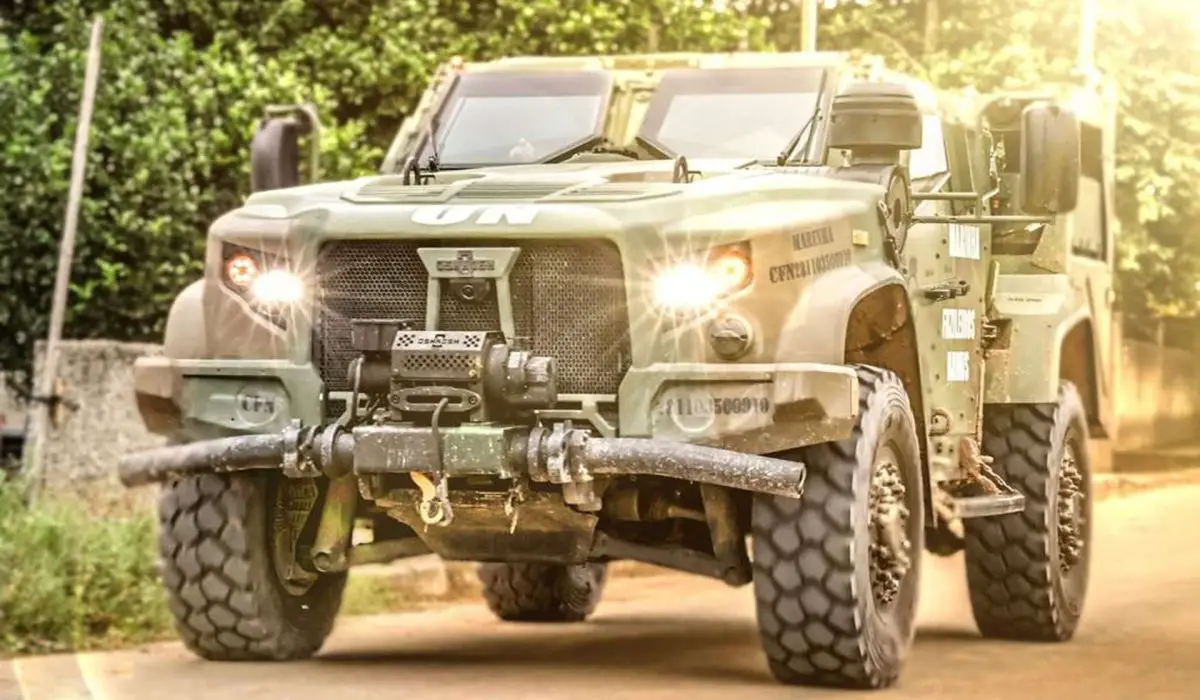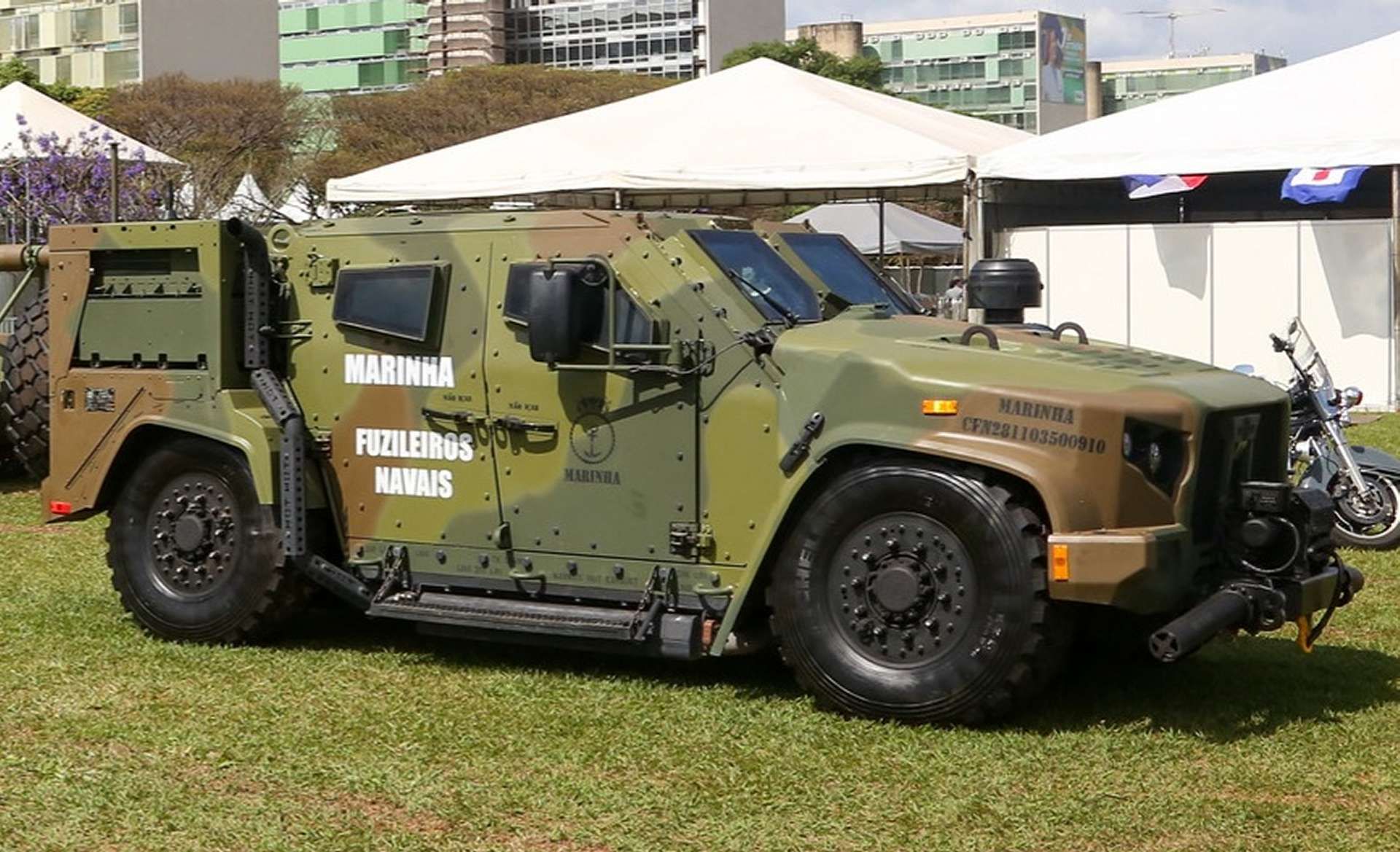Breaking News
Brazilian Marine Corps receives four JLTVs from the US completing a 12-unit order.
On July 17, 2024, the Brazilian Marine Corps received four new Joint Light Tactical Vehicles (JLTVs) from the United States, enhancing their operational capabilities. This purchase, valued at approximately $15.1 million and part of the PROADSUMUS program, aims to improve the Marine Corps' amphibious and expeditionary capacities. It completes the delivery of all 12 units expected to be fully delivered by 2024.
Follow Army Recognition on Google News at this link

The Brazilian Navy began integrating these vehicles in 2022, with the first four units delivered to the Marine Armor Battalion. (Picture source: Brazilian Navy)
These JLTVs are known for their resilience and durability, capable of continuing operations with punctured tires and maintaining a speed of up to 48 km/h for 50 kilometers. They are equipped with 12.7mm and 7.62mm machine guns and a 40mm automatic grenade launcher, providing substantial firepower. Additionally, they feature protective systems such as an Explosively Formed Penetrator (EFP) kit and a B-kit add-on armor system, offering protection comparable to Mine-Resistant Ambush Protected (MRAP) vehicles.
The Brazilian Navy began integrating these vehicles in 2022, with the first four units delivered to the Marine Armor Battalion. These vehicles have already been deployed in various operations, including the Garantia da Lei e da Ordem (Law and Order Guarantee) in the ports of Rio de Janeiro, Itaguaí, and Santos. Their deployment has been instrumental in urban operations, including the "Lais de Guia" under the Navy's jurisdiction.
Vice Admiral (Marine) Rogério Ramos Lage, the Commander of Marine Corps Material, commented on the impact of the new vehicles, noting their contribution to armored protection, mobility, and shock action for the Marine Corps Operational Groups. The JLTVs' integration represents a significant upgrade, particularly for units incorporating these vehicles.

In addition to JLTVs, the PROADSUMUS program includes the acquisition of other military assets such as Unimog 5000 trucks, amphibious assault vehicles, and advanced weapon systems. (Picture source: Brazilian Navy)
The acquisition of JLTVs is part of the broader PROADSUMUS program, which stands for the Marine Corps Combat Power Strategic Program 2020–2040. This program aims to replace older equipment, acquire new capabilities, and improve infrastructure. It includes various procurements and upgrades aimed at enhancing command and control, firepower, and mobility for the Marine Corps and the Navy's CBRN (chemical, biological, radiological, and nuclear) defense organizations.
In addition to JLTVs, the PROADSUMUS program includes the acquisition of other military assets such as Unimog 5000 trucks, amphibious assault vehicles, and advanced weapon systems. These acquisitions aim to improve the operational readiness and flexibility of the Brazilian Marine Corps for national and international operations.
The JLTV project, managed by the United States Army and Marine Corps, was developed to replace the High Mobility Multipurpose Wheeled Vehicles (HMMWV). This decision was based on the need to adapt to modern combat conditions, as evidenced in conflicts like those in Iraq and Afghanistan, where the JLTVs demonstrated resilience against insurgent counterattacks such as roadside explosive devices.
In addition to combat resilience, the JLTVs can be used for infiltrating special operations forces into hostile territories, transporting armaments for Marine Corps Infantry Battalion Fire Support Companies, conducting reconnaissance, performing patrols, establishing observation points, executing surveillance actions, enhancing communications, and escorting convoys. They are equipped with advanced technology, including General Dynamics' smart display units, L3Harris communications systems, and a Gale Banks Engineering V8 turbo-diesel engine based on GM's Duramax architecture. This combination ensures effective performance for various military applications.

The Oshkosh TAK-4i suspension system allows the JLTV to adjust its height for optimized ground clearance and transportability, providing up to 50.8 centimeters of independent wheel travel. (Picture source: Brazilian Navy)
The JLTVs feature a GM Duramax V8 engine paired with an Allison 2500 transmission, providing significant power and reliability. The TAK-4i intelligent independent suspension system offers robust off-road mobility. The vehicle is designed to offer MRAP-level defense against improvised explosive devices (IEDs) and other threats. It can be equipped with additional armor and various weaponry, such as the FN Herstal deFNder Light remote weapon station for the Belgian Falcon variant. The JLTV's adaptability includes future enhancements like hybrid-electric variants, which offer silent drive and extended operational capabilities.
Globally, the JLTV is seeing increasing adoption across various military forces. Over 20,000 units have been produced by Oshkosh Defense as of June 2023. The vehicle is utilized by the U.S. Army, Marine Corps, Air Force, and Navy, as well as several NATO allies and other partner countries. Slovakia, for example, ordered 160 JLTVs in 2023, while Lithuania has an ongoing contract for 350 additional units beyond their initial order of 200.
Furthermore, the JLTV has been utilized as the basis for several other models, including the eJLTV, a hybrid electric version, and two unmanned vehicles developed for the US Marine Corps: the Long Range Fires Launcher (LRFL) and the NMESIS, designed to serve as ground-based Tomahawk launchers.


























